Britain's role in World War II
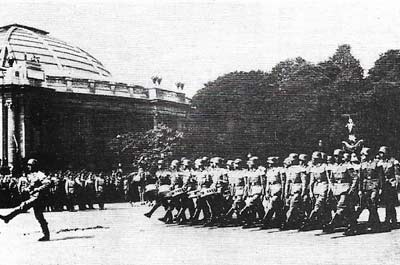
Figure 1. The Allies and Germany faced each other in the West as the outbreak of war became more or less evenly matched in numbers. Britain and France had 122 divisions against Germany's 136, and 3,254 armored vehicles against 2,574. But the Allies still pursued outmoded ideas of positional warfare, and made poor use of their armored divisions. German armor was used to optimum advantage and coupled with air power to form the spearhead of the Blitzkrieg. This was designed to burst through and surround the enemy rather than fight head-on battles. As a result Paris fell in only four weeks.
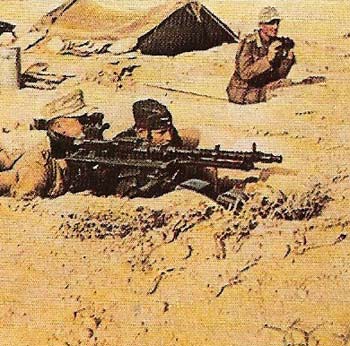
Figure 2. The arrival of Erwin Rommel (1891–1944) and his Afrika Korps in February 1941 rescued his Italian partners from being completely overrun by British and Commonwealth forces in North Africa. Twice Rommel reached the frontiers of Egypt, engendering Allied nightmares of an Axis victory that, together with an advance in Caucasus, could have completed a successful pincer movement.
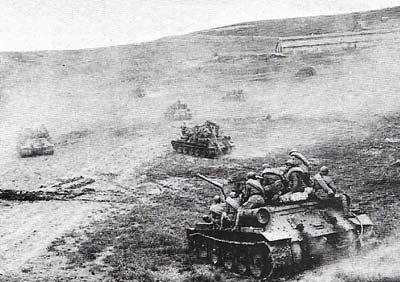
Figure 3. Hitler's invasion of the Soviet Union began brilliantly with the German armies using tactics that had been perfected in Poland and France. Deep-thrusting columns destroyed more than a million enemy troops, but stiffening Soviet resistance and the onset of merciless winter conditions prevented the Germans from achieving the swift victory they needed. Despite some further successes in 1942, the Germans were catastrophically defeated at Stalingrad where they lost 300,000 men. Thereafter they could not hope to match the Soviet Union's apparently inexhaustible manpower and were steadily pushed back.
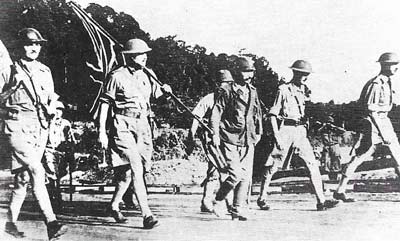
Figure 4. The Japanese captured 85,000 men at Singapore in February 1942: it was the largest surrender in the history of the British Army. Complacency about the Japanese threat had led Britain to neglect already inadequate defenses, but even so British and Commonwealth troops outnumbered the Japanese who swept through Malaya and Burma. The Japanese relied on their mastery of jungle warfare to outflank British troops, who had virtually no jungle training. Singapore was approached and attacked from its lightly defended landward side and fell in a matter of days.
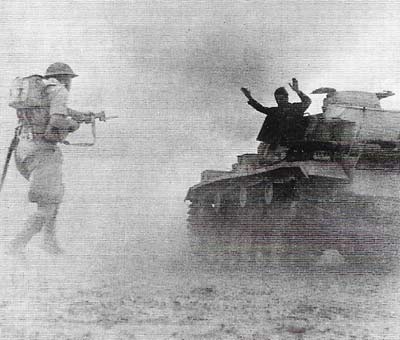
Figure 5. The turning-point in North Africa came in July 1942 when the overstretched Afrika Korps failed to break through British 8th Army positions around El Alamein. Three months later, substantial Allied reinforcements enabled the new commander, Montgomery, to begin an offensive that secured North Africa.
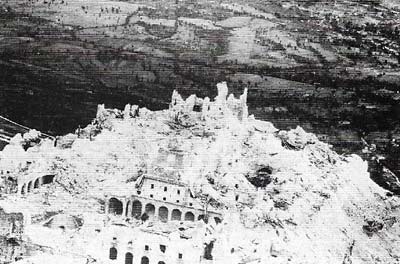
Figure 6. The ruins of Monte Cassino monastery in Italy saw some of the most savage fighting of the war. The Allies believed that the Germans had turned the monastery into a strongpoint: their decision to bomb it not only provoked a controversy, it defeated its own end – the rubble was easier to defend than the intact monastery.
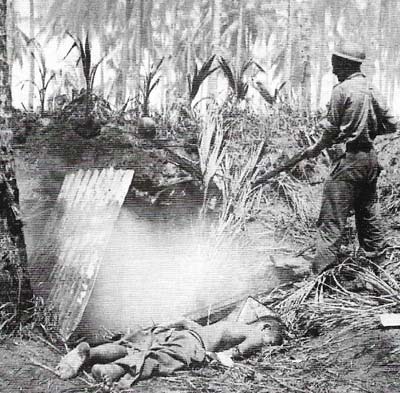
Figure 7. The Japanese in New Guinea suffered their first major setback on land in September 1942 when Australian forces defeated an attempt to capture Port Moresby. After savage fighting in atrocious conditions, the Australians successfully counter-attacked. Throughout 1943 and early 1944, a series of small-scale but brilliant combined operations were mounted as part of a wider Allied offensive in the southwestern Pacific. These isolated and neutralized a whole Japanese army.
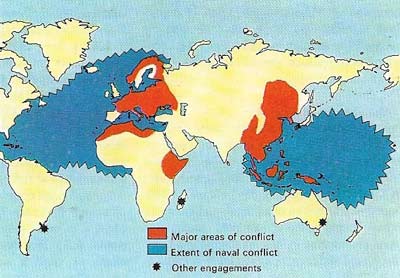
Figure 8. World War II began in Europe, but developed into a global conflict with campaigns in Africa, Asia and throughout the Pacific and Atlantic Oceans. Italy proved a weak member of the Axis in 1940, but Germany and Japan enjoyed a series of victories in the first three years. Thereafter, Allied superiority and potential manpower and industrial capacity steadily grew. More than any previous conflict, this was a war of technology, with developments in tanks, aircraft, submarines, radar - and eventually the atomic bomb - helping to influence strategic and tactical thinking.
Britain's involvement in World War II was global. Though its principal areas of concern were Europe, North Africa and the Far East, the Royal Air Force flew missions on the Russian front and Royal Navy ships fought engagements off South America. And where Britain itself was not heavily involved – notably in the Pacific theatre – Australians and New Zealanders fought along-side Britain's American allies.
Early campaigns
True to the British tradition of losing every battle except the last, the war opened disastrously. Hitler's Blitzkrieg through Poland, the Low Countries and into France (Figure 1) wrecked the British Expeditionary Force of ten divisions: by what seemed a miracle at the time, all but about 25,000 to 30,000 men got back to Britain but the BEF left behind all its heavy equipment.
With the Battle of France lost, the Battle of Britain opened on 10 July 1940 with Goering's Luftwaffe directing its efforts against convoys in the Straits of Dover. The convoys had to be stopped. Phase two, which began on "Eagle Day", 13 August, was aimed at RAF fighter bases in Kent. On 7 September, having lost 225 aircraft to the RAFs 185 in just eight days, the Luftwaffe turned aside to attack London. On 15 September – "Battle of Britain Day" – it lost between 56 and 60 aircraft to the RAF's 26. Chastened, Goering switched to night attacks against English cities, and Operation Sea Lion, the invasion of Britain, was first postponed and finally abandoned altogether after the invasion of Russia. The blitz, during which some 30,000 people were killed, continued until mid-April 1941.
The dark days
A consequence of the fall of France was that the German navy was able to operate U-boats from France's west coast. In the first year of the war the U-boats never numbered more than 60, but they sank nearly a million tons of merchant shipping. The Battle of the Atlantic reached its peak in early 1941, but by the summer of 1943, the convoy system and American involvement prevailed.
In the Balkans, Hitler's seven-week campaign through Yugoslavia and Greece ended with the British being ejected from Crete in May 1941.
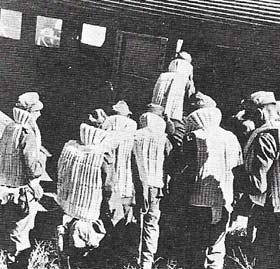 |
| German paratroops, here entering a JU52 transport aircraft, proved decisive in the capture of Crete, the final phase of Hitler's Balkan campaign. Bernard Freyberg (1889–1963), commander of the New Zealand Division, was in charge of all the forces on the island. Using 1,390 aircraft, the Germans forced the British to withdraw on 27 May, after three weeks' stubborn resistance. |
Germany's assault on Russia on 22 June 1941 (Figure 3) offered Britain a breathing-space. Britain could do little to help Russia beyond offering supplies: and the route to Murmansk and Archangel was, in the winter, the worst sea-route in the world.
While the Battle of the Atlantic and of the Russian convoys was under way, Britain was losing in the Far East. The Japanese attack on the US base at Pearl Harbor on 7 December 1941 was followed by the ignominious fall of Singapore (Figure 4), the loss of the battlecruiser Repulse and the battleship Prince of Wales, and a threat to India. The Japanese were within 200 miles of Australia: Australia and New Zealand, with most of their troops in North Africa, had to turn to the United States for protection.
Towards final victory
The tide began to turn in 1942. In North Africa, after a see-saw series of battles in which the Italians and Erwin Rommel's Afrika Korps (Figure 2) got to within 60 miles of Alexandria, and Australian and British units distinguished themselves by stubborn resistance in the isolated pocket of Tobruk, Montgomery won the Battle of El Alamein (Figure 5). The battle opened on 23 October; on 4 November Rommel's Afrika Korps began to retreat; four days later Anglo-American forces landed in French North Africa. With victory in North Africa in the spring of 1943, Italy became the next objective. Sicily was invaded in July 1943 and mainland Italy – by the British 5th Army at Salerno – in September. American insistence that the Pacific and Burma campaigns be given priority in late 1943 meant, however, that the Italian campaign was drawn out. Of the Commonwealth troops who had fought in Africa, the New Zealanders went on to fight in Italy, notably at Monte Cassino (Figure 6) and the Australians returned home to help push the Japanese out of the Pacific.
The Mediterranean campaign ended effectively with the capture of Rome on 4 June 1944, although the German resistance in Italy did not end until May 1945.
The invasion of Normandy began on 6 June 1944, British troops landing on the coast near Caen and Bayeux and Americans farther west. After an initial period of close fighting in France, the Allies broke out and swept towards the Rhine. An attempt to speed matters by an airborne landing at Arnhem in The Netherlands failed, but in the spring of 1945 renewed offensives resulted in Germany's surrender on 7 May.
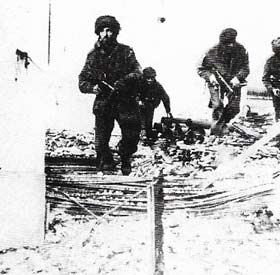 |
| British paratroops experienced nine days of bitter street fighting - and final failure – at Arnhem in September 1944 when, with American and Polish forces, they attempted to capture 17 canal crossings and major bridges in Holland. Of the 35,000 troops involved, more than 17,000 became casualties. Four of the five major bridges were taken; the bridge at Arnhem was not. The plan devised by Montgomery – dashing, and contrary to his usual style - might have shortened the war had it worked. |
In the Far East Slim's "forgotten" 14th Army had been confronting the Japanese in Burma while Americans, Australians and New Zealanders island-hopped towards Japan following the Battle of Midway, an American carrier-fleet victory that ranked with Stalingrad in strategic importance. Two atomic bombs, on Hiroshima and Nagasaki, ended the war against Japan.
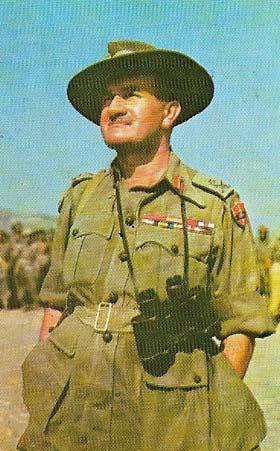 |
| Lieutenant-General William Joseph Slim (1891–1970) commanded the 14th British Army in Burma. In June 1944, he defeated a Japanese attempt to invade India at Kohima and Imphal, and then successfully went on to liberate the country. |
Britain lost far fewer men in World War II than in World War I – 300,000 dead against 750,000. Civilian casualties were higher: 60,000 against 1,500. The legacy of the war was an enormous economic debt – £4,198 million – the loss of an empire and, in compensation, an industrial leap forward.
